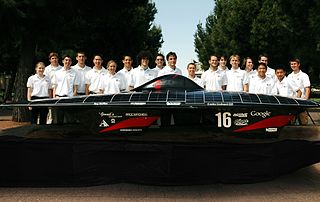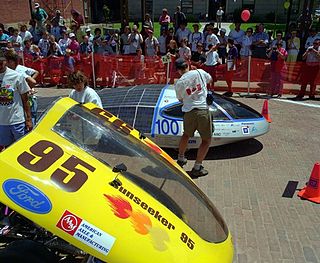
The American Solar Challenge (ASC), previously known as the North American Solar Challenge and Sunrayce, is a solar car race across the United States. In the race, teams from colleges and universities throughout North America design, build, test, and race solar-powered vehicles in a long distance road rally-style event. ASC is a test of teamwork, engineering skill, and endurance that stretches across thousands of miles of public roads.

The University of Calgary Solar Car Team is a multi-disciplinary student-run solar car racing ("raycing") team at the University of Calgary, based in Calgary, Alberta, Canada. It was established to design and build a solar car to compete internationally in the American Solar Challenge (ASC) and the World Solar Challenge (WSC). The team is primarily composed of undergraduate students studying Engineering, Business, Science, Arts and Kinesiology. The mission of the University of Calgary Solar Car Team is to educate the community about sustainable energy and to serve as an interdisciplinary project through which students and faculty from various departments can collaborate in supporting sustainable energy.

The Stanford Solar Car Project (SSCP) is a student group at Stanford University that designs, builds, tests, and races solar-powered vehicles. The SSCP, a student-run, donation-funded organization, has been building and racing solar-powered vehicles since 1986. The team's most recent car, Arctan, was unveiled in July 2015 and placed sixth in the Challenger Class of the 2015 World Solar Challenge. Previous cars have competed and placed at previous World Solar Challenges, the Global Green Challenge, and American Solar Challenge.

The University of Michigan Solar Car Team is a 501(c)(3) non-profit organization at the University of Michigan in Ann Arbor. It is the most successful solar car team in North America, having won the North American Solar Challenge (NASC) eight times. The team has also placed third in the World Solar Challenge (WSC) five times. Six of its former vehicles are on display in museums in the United States, including the Henry Ford Museum, the Museum of Science and Industry in Chicago, and the Boston Museum of Science.
The Queen’s University Solar Vehicle Team (QSVT) was a dynamic, multidisciplinary student design project at Queen's University, Kingston, Ontario, Canada, whose goal was to design and build vehicles that are solely powered by the sun’s energy. One of the two original Canadian teams, the Queen’s University Solar Vehicle Team designed, built and raced solar powered vehicles for twenty years. During this time the team rose to be one of the top teams on the international solar car racing circuit, participating in numerous solar vehicle races, including The Canadian Solar Discovery Challenge, the North American Solar Challenge (NASC) and the World Solar Challenge.

The UNSW Solar Racing Team is the solar car racing team of the University of New South Wales in Sydney, Australia. The team currently holds a number of world records and is best known for its participation in the World Solar Challenge (WSC). Since its founding in 1996 by Byron Kennedy, the Sunswift team has built a total of 6 different cars, the most recent of which is Sunswift VI.

The University of Minnesota Solar Vehicle Project, or UMNSVP, is a team of undergraduate students from the University of Minnesota that designs and constructs solar-powered cars. In its 29 years, it has established itself as one of the world's top solar racing teams, and the top Cruiser/MOV team in the Western Hemisphere, with top-two finishes in eighteen of thirty-four events entered.
PrISUm Solar Car is the multidisciplinary student-run solar car racing team from Iowa State University that designs and builds solar powered vehicles to compete in the American Solar Challenge (ASC). The club was founded in 1989 by a group of engineering honor students from Tau Beta Pi and was simply known as the ISU Solar Car Project. In 1990, the team adopted the name of its first car, PrISUm.

Durham University Electric Motorsport (DUEM) is a student-run team in the United Kingdom that designs and constructs solar powered cars to compete in international competitions. DUEM is the longest running solar car team in the UK and is financed entirely by third party donations and sponsorship.
The Sunshark Solar Car Team was a solar car racing team at the University of Queensland in Brisbane, Australia.

The 1993 Maize & Blue solar car was built by the University of Michigan Solar Car Team during the period from 1990 to 1993.
The Solar Car Challenge is an annual solar-powered car race for high school students. The event attracts teams from around the world, but mostly from American high schools. The race was first held in 1995. Each event is the end product of a two-year education cycle launched by the Winston Solar Car Team. On odd-numbered years, the race is a road course that starts at the Texas Motor Speedway, Fort Worth, Texas; the end of the course varies from year to year. On even-numbered years, the race is a track race around the Texas Motor Speedway. Dell sponsored the event from 2002-2008. Hunt Oil Company sponsored the 2010 race.
Solar car racing refers to competitive races of electric vehicles which are powered by solar energy obtained from solar panels on the surface of the car. The first solar car race was the Tour de Sol in 1985 which led to several similar races in Europe, US and Australia. Such challenges are often entered by universities to develop their students' engineering and technological skills, but many business corporations have entered competitions in the past. A small number of high school teams participate in solar car races designed exclusively for high school students.
The Cal State LA Solar Car Team is an engineering team from California State University, Los Angeles. The team develops the Solar Eagle, a series of solar cars that have taken part in solar car races in the United States and in Australia.

The Midnight Sun Solar Rayce Car Team is a Canadian solar car race team affiliated with the University of Waterloo of Waterloo, Ontario. Founded in 1988, the Midnight Sun team is a student-run organization which designs and builds a solar vehicle every two to three years to compete in two solar challenges; the World Solar Challenge, held in Australia, and the American Solar Challenge, held in the United States. The team's roster recruits from every department on campus, resulting in a diverse, innovative team and work environment.

The UltraCommuter was a hybrid electric concept car first designed by the University of Queensland Sustainable Energy Group and unveiled in 2005. In 2007 the project was transferred to the Waikato University School of Engineering and further developed in conjunction with HybridAuto Pty.

The Sunseeker Solar Car Project, Sunseeker for short, is Western Michigan University's solar car team. Each vehicle is designed, built, maintained, and raced by students. Sunseeker has competed in all of the American Solar Challenge events, going back to 1990.
Eolian is the name of a series of solar vehicles designed and manufactured by students, workers and professors at the University of Chile. The project involves different disciplines, including mechanical engineers, electrical engineers and industrial designers.
SolarMobil Manipal is the official Solar Car student team of Manipal University, Manipal. The team, founded in 2011 by a group of engineering students of Manipal Institute of Technology, is the third Indian solar car team and the first Indian team to build a passenger solar car. SolarMobil is a student project aimed at research & development of solar powered electric vehicle.

Sonnenwagen Aachen is a current project by students from RWTH Aachen University and FH Aachen for the development and construction of a solar car, to participate in the World Solar Challenge in Australia. The solar car race with a length of 3022 km from Darwin in Northern Territory to Adelaide in South Australia is known to be the longest solar car race in the world and has celebrated its 30th anniversary in October 2017.


















